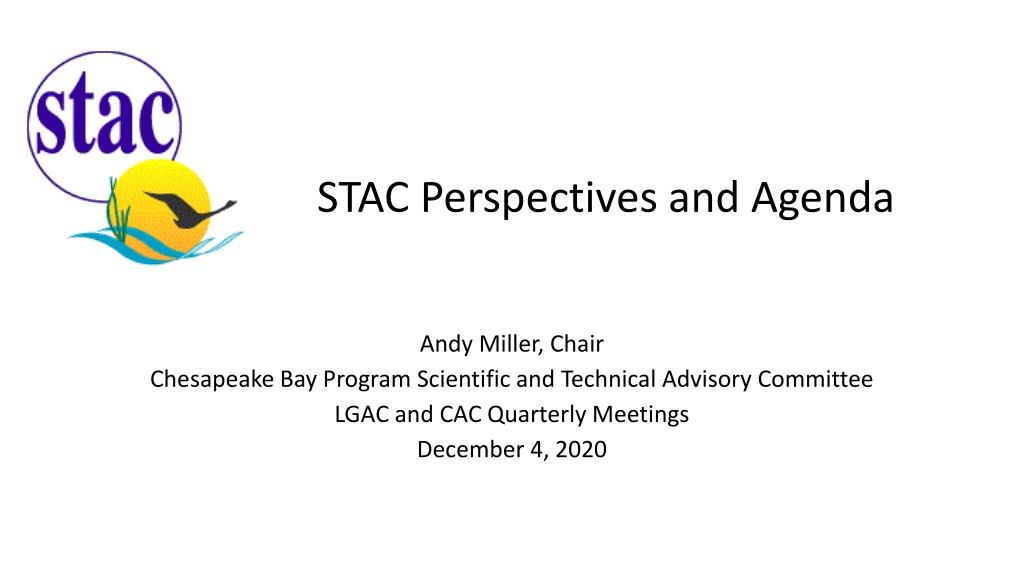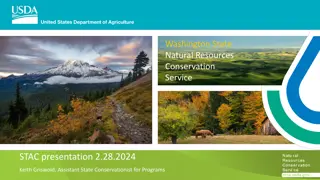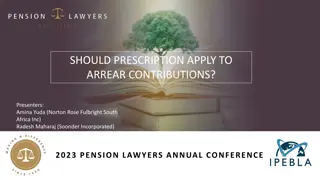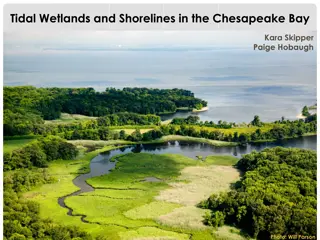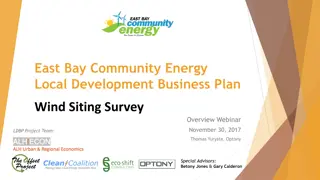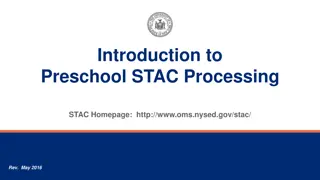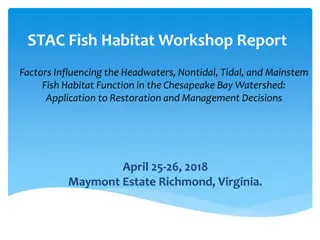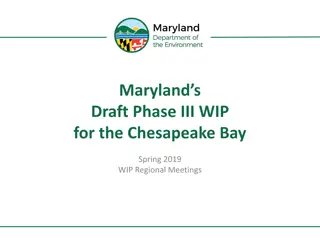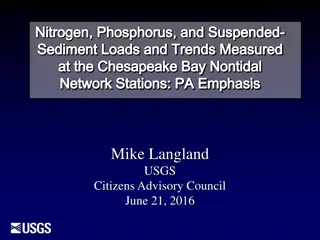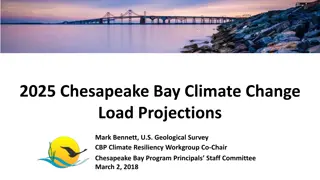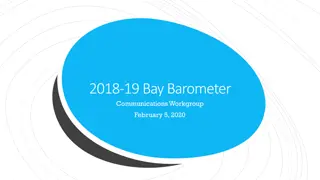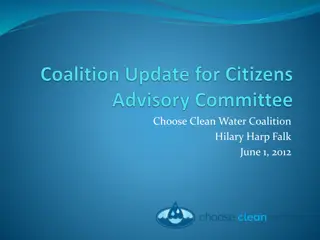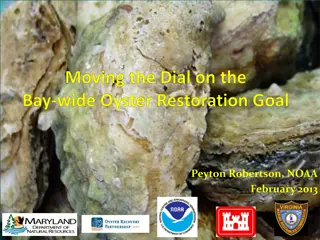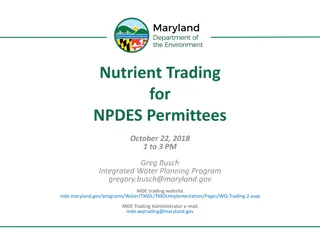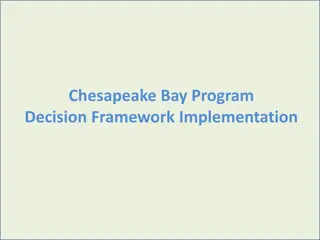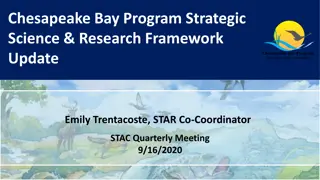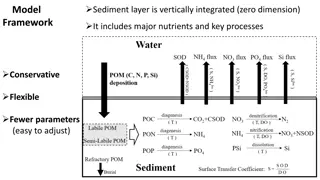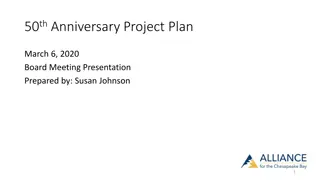Chesapeake Bay STAC Overview and Key Contributions
Chesapeake Bay Scientific and Technical Advisory Committee (STAC) comprises 37 volunteers from various institutions providing scientific and technical advice to the Chesapeake Bay Program. STAC members contribute time valued at over $500,000 annually, offer recommendations, and focus on technical reports, reviews, and workshops. The committee supports the program without direct involvement in policy, emphasizing guidance, support, and diversity considerations.
Uploaded on Oct 08, 2024 | 0 Views
Download Presentation

Please find below an Image/Link to download the presentation.
The content on the website is provided AS IS for your information and personal use only. It may not be sold, licensed, or shared on other websites without obtaining consent from the author. Download presentation by click this link. If you encounter any issues during the download, it is possible that the publisher has removed the file from their server.
E N D
Presentation Transcript
STAC Perspectives and Agenda Andy Miller, Chair Chesapeake Bay Program Scientific and Technical Advisory Committee LGAC and CAC Quarterly Meetings December 4, 2020
Chesapeake Bay STAC who are we and what do we do? 37 volunteers from academic institutions, public agencies and NGOs representing every jurisdiction in the Bay watershed partnership Supported by the professional staff of the Chesapeake Research Consortium and working in collaboration with the Chesapeake Bay Program staff and others Last year our members contributed time with an estimated cumulative value of more than $500,000 in service to the watershed partnership We provide scientific and technical advice through technical reports and position papers, reviews of CBP programs and projects, organization of technical workshops and workshop reports, and direct interaction with the Chesapeake Bay Program We carry out reviews both to meet programmatic needs and to identify emerging issues of concern to the watershed partnership We don t get directly involved in policy but we do offer policy-relevant recommendations
A few key points from the Executive Council presentation This spring there were conversations among the leaders of the three Advisory Committees and there was a paragraph with common language in each of our three letters to the Executive Council Our main objective was to remind the leadership of our long history of providing guidance and support offer our continued support for the watershed partnership during this time of public-health and economic crisis, and request that we be consulted about important decisions We also spoke in support of the Chesapeake Bay Program s Diversity, Equity, Inclusion and Justice Statement; STAC is currently involved in its own internal discussions and planning to make progress on this important issue
Some recent and forthcoming products September 2019 report on Revisiting Coastal Land-Water Interactions: The Triblet Connection October 2019 report on Microplastics in the Chesapeake Bay and its Watershed, some of whose recommendations have already led to action by relevant working groups within the Bay Program; February 2020 report on Increasing Effectiveness and Reducing the Cost of Nonpoint Source BMP Implementation: Is Targeting the Answer?; March 2020 workshop report on Assessing the Environment in Outcome Units: Using Eutrophying Units for Management, characterizing nutrient species for their relative impacts rather than focusing only on total N and P; A March 2020 workshop on Incorporating Freshwater Mussels in the Chesapeake Bay Partnership is in preparation for publication and will also make recommendations about research needs and the potential role of freshwater mussels in the Bay restoration effort Four other workshop reports published June 2019-2020, five new workshops planned for the current fiscal year with a new RFP about to be released for FY22
Additional ongoing work Two science synthesis projects on challenges associated with achieving Bay restoration goals under a changing climate: Investigating impacts of climate change and eutrophication on dissolved oxygen in shallow waters of Chesapeake Bay; Examining climate-change impacts on watershed processes, nutrient delivery, and BMP performance Both to be delivered in 2021 Ongoing STAC-wide effort: Comprehensive Evaluation of System Response to measures taken to meet water quality standards, incorporating watershed processes, estuarine dynamics and living resources report expected by the end of 2021
The future Chesapeake Bay: chasing a moving target Future Urban Climates project Washington, D.C. in 2080 resembles Greenwood, Mississippi of 2020 Global Warming in the Free State, 2008
Ongoing and future migration of the land- water boundary NOAA Sea-Level Rise Viewer Chesapeake Bay in 2080: intermediate forecast of +3.12 ft
STAC Request for Input on COVID STAC Request for Input on COVID- -19 Impact on Partnership Outcomes 19 Impact on Partnership Outcomes We are hoping for input from across the watershed partnership to help us define the scope of a series of mini-workshops to identify impacts, changing dynamics, and novel insights from COVID-19 We will use these findings to host several short-form 90-minute discussions to inform current and future efforts to reach management targets for the Bay Some of these topics may be of particular interest to CAC and LGAC; STAC does not need to take the lead on all of these and would be happy to collaborate We have created an online survey to solicit interest: https://www.surveymonkey.com/r/HRCK7XD Timing: January-April 2021?
STAC Request for Input on COVID STAC Request for Input on COVID- -19 Impact on Partnership Outcomes 19 Impact on Partnership Outcomes STAC has done some recent brainstorming on this issue and here are some examples of impacts we identified for discussion: Change in nutrient load from shifts in atmospheric deposition and water use/wastewater treatment (PWS vs septic, etc.) Altering human behavior, altering living resources: change in water quality, habitat, ability to assess progress Changing fishing pressure (less restaurant demand, less commercial, more recreational overall decreased pressure on fish populations?) Disruption to agricultural production: disruption in agricultural supply chain that resulted in destruction of crops/flocks/herds, milk dumping
STAC Request for Input on COVID STAC Request for Input on COVID- -19 Impact on Partnership Outcomes 19 Impact on Partnership Outcomes More topics: Increased visitation/use/impact of public/outdoor spaces for recreation, esp. in urban areas (Potomac, more); environmental justice/who has access Loss of some monitoring data and increased monitoring expenses due to social-distancing protocols Public health effects, unemployment and loss of tax revenues for regulatory enforcement, BMP installation, water quality monitoring Are CAC and LGAC interested in participating in or taking the lead on any of these topics? Are there other topics that should be added to the list?
STAC Request for Input on COVID STAC Request for Input on COVID- -19 Impact on Partnership Outcomes 19 Impact on Partnership Outcomes The questionnaire: 1. STAC has begun brainstorming on this issue and below are some examples of impacts we have identified for discussion. From the list below, please rank the highest priority ideas for further discussion. (listed items are on previous slides) 2. Are any important impacts on the Bay missing from this list? 3. What risks, changes in the Bay, and learning opportunities do you see in the short and long-term due to COVID-19? 4. Are there any individuals or groups that would be important to include for any of the above topics? 5. Your name and affiliation
